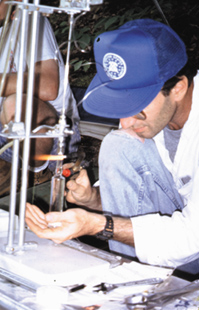
Geotimes Home | AGI Home | Information Services | Geoscience Education | Public Policy | Programs | Publications | Careers

 Ironically,
a group from the Toxics program visited Sandia National Laboratories on September
11 to discuss field testing new technology out of Sandia that allows for real-time
detection of water contaminants (Geotimes, January 2002). But, despite
the natural connection between water security and homeland security, the proposed
budget gives USGS water programs no money to help prevent terrorist attacks on
the U.S. water supply. The transfer would shut down long-term research sites,
some of which have been operating for close to 20 years.
Ironically,
a group from the Toxics program visited Sandia National Laboratories on September
11 to discuss field testing new technology out of Sandia that allows for real-time
detection of water contaminants (Geotimes, January 2002). But, despite
the natural connection between water security and homeland security, the proposed
budget gives USGS water programs no money to help prevent terrorist attacks on
the U.S. water supply. The transfer would shut down long-term research sites,
some of which have been operating for close to 20 years. Toxics-sponsored
projects can run from months to years. Project length depends on what is found
and the needs of the site. Research hydrologist Allen Shapiro has been studying
how contaminants flow through fractured rock at a Toxics site in the Hubbard Brook
Experimental Forest in New Hampshire for 17 years. His work at this uncontaminated
site has allowed for the development and transfer of methods and technology for
scientists to study related problems at sites around the world.
Toxics-sponsored
projects can run from months to years. Project length depends on what is found
and the needs of the site. Research hydrologist Allen Shapiro has been studying
how contaminants flow through fractured rock at a Toxics site in the Hubbard Brook
Experimental Forest in New Hampshire for 17 years. His work at this uncontaminated
site has allowed for the development and transfer of methods and technology for
scientists to study related problems at sites around the world. On the Web:
USGS Toxics Program
NAWQA
NRP
NSIP
State Water Resources Research Institute Program
Office of Science and Technology
American Geological Institute's Government
Affairs Program
 |
Geotimes Home | AGI Home | Information Services | Geoscience Education | Public Policy | Programs | Publications | Careers |